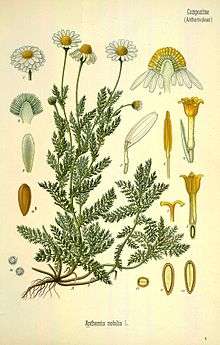Chamaemelum nobile
Chamaemelum nobile commonly known as chamomile (also spelled camomile) or under its synonym Anthemis nobilis, Roman chamomile,[2] English chamomile,[2] garden chamomile, ground apple, low chamomile, mother's daisy or whig plant,[3] is a low perennial plant found in dry fields and around gardens and cultivated grounds in Europe, North America, and in Argentina. C. nobile is, along with Matricaria chamomilla, an important source of the herbal product known as chamomile.[2]
| Chamomile | |
|---|---|
 | |
| Chamaemelum nobile[1] | |
| Scientific classification | |
| Kingdom: | Plantae |
| Clade: | Tracheophytes |
| Clade: | Angiosperms |
| Clade: | Eudicots |
| Clade: | Asterids |
| Order: | Asterales |
| Family: | Asteraceae |
| Genus: | Chamaemelum |
| Species: | C. nobile |
| Binomial name | |
| Chamaemelum nobile | |
| Synonyms | |
|
Anthemis nobilis L. | |

Description
Chamaemelum nobile has daisy-like white flowers and procumbent stems; the leaves are alternate, bipinnate, finely dissected, and downy to glabrous. The solitary, terminal flowerheads, rising 20–30 cm (8–12 in) above the ground, consist of prominent yellow disk flowers and silver-white ray flowers. The flowering time in the Northern Hemisphere is June and July, and its fragrance is sweet, crisp, fruity and herbaceous.[4] Although the plant is often confused with German chamomile (M. chamomilla), its morphology, properties and chemical composition are markedly different.[5]
Etymology
The word chamomile, and the genus name Chamaemelum come from the Greek χαμαίμηλον (chamaimēlon), "earth-apple",[6] from χαμαί (chamai), "on the ground" + μήλον (mēlon), "apple", so-called because of the apple-like scent of the plant. (Note: The "ch-" spelling is used especially in science and pharmacology.). The plant obtained the name "nobile" (Latin, noble) because of its putative therapeutic properties, which were believed to be better than those of the German chamomile (Matricaria chamomilla L.)[7][8]
History
Roman chamomile (C. nobile L.) is known as a medicinal plant from the middle ages.[8] The European cultivation of the plant started in England in the 16th century.[7] The plant was listed first in the pharmacopoeia of Würtenberg as a carminative, painkiller, diuretic and digestive aid.[8][9]
Non-medicinal use
The plant is used to flavor foods, in herbal teas, perfumes, and cosmetics.[4] It is used to make a rinse for blonde hair, and is popular in aromatherapy; its practitioners believe it to be a calming agent to reduce stress and aid in sleep.
It can also be used to create a fragrant chamomile lawn. A chamomile lawn needs light soil, adequate moisture, and sun in order to thrive. Each square meter contains 83-100 plants. The lawn is only suitable to light foot traffic or in places where mower access is difficult.[10]
Folk medicine
In folk medicine, it may be applied directly to the skin to reduce pain and swelling, with several scientific studied giving credence to such purported analgesic and anti-inflammatory properties.[11][12][13][14] According to MedlinePlus It is not recommended to be taken orally in medicinal amounts during pregnancy as it is believed it may cause a miscarriage.[15] There are no known interactions with other herbs and supplements or foods.[15]
Other names
Anthémis, Anthémis Odorante, Anthemis nobilis, Babuna Ke Phool, Camomille d’Anjou, Camomille Noble, Camomille Romaine, Chamaemelum nobile, Chamomilla, Chamomile, Chamomillae Ramane Flos, English Chamomile, Fleur de Camomille Romaine, Flores Anthemidis, Garden Chamomile, Grosse Kamille, Ground Apple, Huile Essentielle de Camomille Romaine, Low Chamomile, Manzanilla, Manzanilla Romana, Ormenis nobilis, Roman Chamomile Essential Oil, Romische Kamille, Sweet Chamomile, Whig Plant.[15]
References
- 1897 illustration from Franz Eugen Köhler, Köhler's Medizinal-Pflanzen
- "German Chamomile". University of Maryland Medical Center. 2011. Retrieved 14 December 2012.
- T. K. Lim Edible Medicinal And Non-Medicinal Plants: Volume 7, Flowers at Google Books
- Gualtiero Simonetti (1990). Stanley Schuler (ed.). Simon & Schuster's Guide to Herbs and Spices. Simon & Schuster, Inc. ISBN 0-671-73489-X.
- Moumita., Das (2014). Chamomile : medicinal, biochemical, and agricultural aspects. Boca Raton: CRC Press. ISBN 9781466577602. OCLC 881886704.
- Chamaimelon, Henry George Liddell, Robert Scott, A Greek-English Lexicon, at Perseus
- Hiller, Karl; Melgiz, Matthias F. (1999). Lexikon der Arzneipflanzen und Drogen. Heidelberg: Spektrum Akademischer Verlag GmbH.
- European Medicines Agency (EMA) (2012). Assessment Report on Chamaemelum nobile (L.) All., flos. EMA, London.
- Lukacs M. (1990) [The phytochemical investigation of Anthemis nobilis L.] PhD Thesis, Szent-Györgyi Albert Medical University Szeged.
- "Camomile lawn". rhs.org. Retrieved 21 July 2015.
- Al-Snafi, Ali E. "MEDICAL IMPORTANCE OF ANTHEMIS NOBILIS (CHAMAEMELUM NOBILE) -A REVIEW". Cite journal requires
|journal=(help) - Aremu, Olukayode O.; Tata, Charlotte M.; Sewani-Rusike, Constance R.; Oyedeji, Adebola O.; Oyedeji, Opeoluwa O.; Nkeh-Chungag, Benedicta N. (2018). "Phytochemical composition, and analgesic and antiinflammatory properties of essential oil of Chamaemelum nobile (Asteraceae L All) in rodents". Tropical Journal of Pharmaceutical Research. 17 (10): 1939–1945. doi:10.4314/tjpr.v17i10.7. ISSN 1596-9827.
- Kazemian, Hossein; Ghafourian, Sobhan; Heidari, Hamid; Amiri, Pouya; Yamchi, Jalil Kardan; Shavalipour, Aref; Houri, Hamidreza; Maleki, Abbas; Sadeghifard, Nourkhoda (July 2015). "Antibacterial, anti-swarming and anti-biofilm formation activities of Chamaemelum nobile against Pseudomonas aeruginosa". Revista Da Sociedade Brasileira De Medicina Tropical. 48 (4): 432–436. doi:10.1590/0037-8682-0065-2015. ISSN 1678-9849. PMID 26312934.
- "Chamomile tea for relief of primary dysmenorrhea | Request PDF". ResearchGate. Retrieved 2020-08-02.
- "Roman chamomile". medlineplus.gov. US National Institutes of Health. Retrieved 3 August 2017.

![]()
External links
- English chamomile entry in the public domain NCI Dictionary of Cancer Terms
- Chamomile Plantlife website - species listing
| Wikimedia Commons has media related to Chamaemelum nobile. |
| Wikispecies has information related to Chamaemelum nobile |
